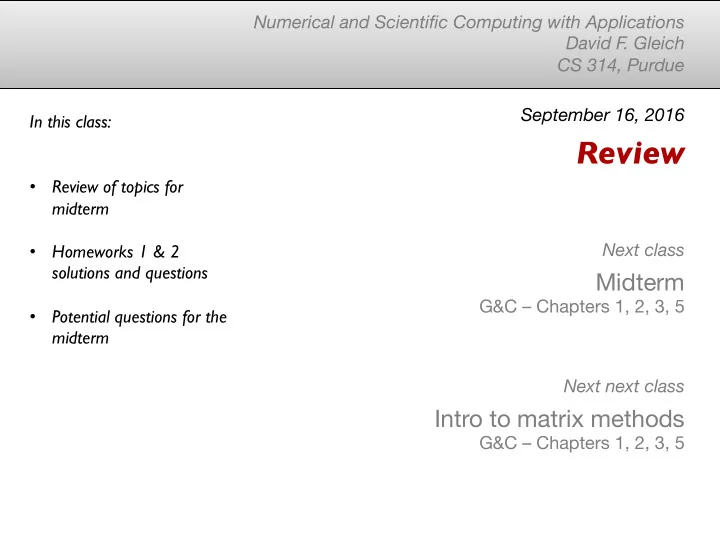

Numerical and Scientific Computing with Applications David F . Gleich CS 314, Purdue September 16, 2016 In this class: Review • Review of topics for midterm Next class • Homeworks 1 & 2 solutions and questions Midterm G&C – Chapters 1, 2, 3, 5 • Potential questions for the midterm Next next class Intro to matrix methods G&C – Chapters 1, 2, 3, 5
… the midterm …
Background I assume Linear algebra Calculus Differential equations Discrete math Programming Probability I’ll try to remind you what you need to know
Topics we’ve covered Week 1 Week 3 Week 4 Details of the class The need for floating point Monte Carlo methods History of numerical IEEE Floating point The Monte Hall prob computing representations Integrating a circle. The importance of General floating point Google’s random surfer numerical computing systems Monte Carlo integration + Mathematical modeling How to add/sub/mult with variance computations floating point The XKCD raptor problem Central limit theorem & IEEE Rounding modes Google’s PageRank accuracy Floating point guarantees Week 2 Floating point properties Variables and expressions in Julia IEEE Exceptions Matrix and vector Problematic floating point operations in Julia computations Control flow in Julia
Homework questions Homework 1 Homework 2 Drunkard’s walk (or random walk on Floating point representations a line) Converting random number A simple economy generators Acceleration and raptors Nearest number Writing matrices for search engines Relative roundoff error Simple Matlab operations Floating point exceptions Mandelbrot Fibonacci roots & floating point Fun with floats! Monte Carlo integration The Birthday paradox Random walks and birthdays
Homeworks 1 & 2
Potential questions for the midterm A trinary digit is a value that is either 0, 1, 2. Consider a floating point system with trinary digits (“trits”). Suppose that we use 3 trits for the mantissa to represent (t1.t2t3) 3 . (This is not a hidden bit representation.) And the set of exponents is -1, 0, 1 (just one trit). Suppose also that we use one trit for the sign. List all (non-negative) floating point numbers in repeating decimal notation with exponent 0 Is the floating point representation of 0 unique? How many ways are there to represent 1/3 (decimal) in this system?
Monte Carlo methods PageRank by 3 What is the probability of Taking a random walk from node 2 5 3 to node 5 (assuming we start 4 at node 3). 1 6
Monte Carlo Methods Write pseudocode to estimate the following probability. What is the probability that two circles with radius 1 will intersect if their centers are drawn with x and y coordinates that have a random normal distribution with mean 0 and variance 1?
Solution function circle_intersect() c1 = randn(2) c2 = randn(2) if norm(c1-c2) <= 1 # if the distance between return 1 # centers <= 1, they intersect else return 0 end end Wins = 0 for t=1:ntrials wins += circle_intersect() End Wins/ntrials
What does the following code do? N = 50 x = linspace(0,1,N) y = zeros(N) For i=1:N y[i] = sin(x[i]^2) End Plot(x,y,title=@sprintf(“.18f”, sum(y)))
Mathematical Models Suppose that we want to simulate a race between two sprinters started by a flag signal. Sprinter 1 runs at 10 m/s and accelerates to this speed in 0.1 s. Sprinter 2 runs at 10.1 m/s and accelerates to this speed in 0.15 s. Describe an assumption we would need to make to simulate a race.
Monte Carlo Integration Explain which figure illustrates Riemann-style integration and which illustrates Monte Carlo integration.
Relative importance to exam Week 1 Week 3 Week 4 Details of the class The need for floating point Monte Carlo methods History of numerical IEEE Floating point The Monte Hall prob computing representations Integrating a circle. The importance of General floating point Google’s random surfer numerical computing systems Monte Carlo integration + Mathematical modeling How to add/sub/mult with variance computations floating point The XKCD raptor problem Central limit theorem & IEEE Rounding modes Google’s PageRank accuracy Floating point guarantees Week 2 (Important to read!) Floating point properties Variables and expressions IEEE Exceptions in Julia Problematic floating point Matrix and vector computations operations in Julia Control flow in Julia
Recommend
More recommend